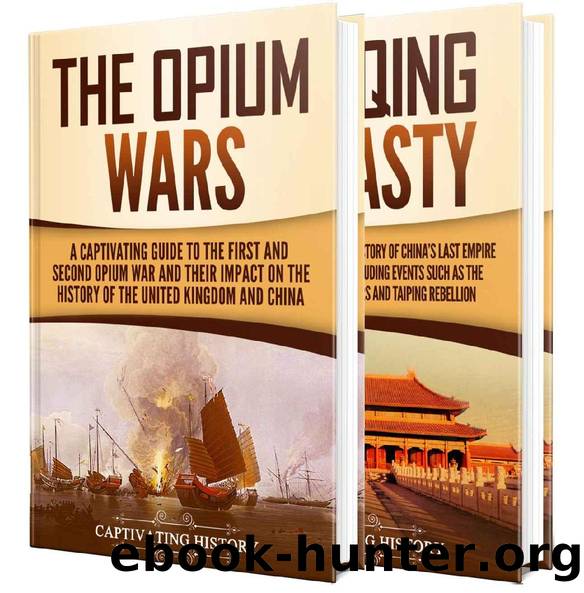Opium Wars: A Captivating Guide to the First and Second Opium War and the History of the Qing Dynasty by Captivating History

Author:Captivating History [History, Captivating]
Language: eng
Format: epub
Published: 2020-10-05T00:00:00+00:00
A soldier with the Manchu queue hairstyle.
Source: https://en.wikipedia.org/wiki/Queue_(hairstyle)
This act faced resistance among the Han Chinese, who regarded their own hairstyle as a sign of their cultural identity. Mixed with loyalty to the Ming dynasty, this defiance provoked the Manchu to slaughter entire populations in some parts of China. The numbers often went above tens of thousands in just one city, and the stories of these massacres survived for hundreds of years, often serving as fuel for anti-Qing movements, especially during the late 19th and early 20th centuries.
Reforms under the New Qing Dynasty
It took over forty years for the Qing dynasty to consolidate its power over China. Even though they proclaimed equality amongst all the peoples that inhabited the empire, somehow, the Manchus were always the majority when it came to choosing the state and court officials. Dorgon, even though just a regent to the young emperor, became the very embodiment of the state, which gave him more power than any regent ever had. Even the emperorâs coronation speech confirmed the power Dorgon wielded. He took several Chinese officials under his own command, showing goodwill to change Manchu supremacy and work more on equality within the empire. Dorgon installed new metropolitan level exams, and every Han Chinese who passed them had a waiting position in the lower Qing bureaucracy. Thousands of people passed these exams and became civil officials, who served throughout the country.
The military also went through some significant reforms during the rule of Dorgon. He saw the importance of organizing garrisons for the Banners inside China proper (which refers to Inner China without the conquered regions). Between 1644 and 1669, around two million acres of land were distributed to the troops of the Banners and their families. This land consisted of farms, households, and agricultural fields, which families of the men who served the army inhabited and worked. Reports say that 40,000 men and their families serving under the Banners received six acres of land per person inside a single household. Senior officers of the Manchu armies received much larger estates.
Citizens who moved from the original Manchu lands in Liaodong to China organized Manchu enclaves known as Manchu cities. They were described by historians as half-garrison, half-city, where soldiers and their families lived. They served as administrative centers with the looks of ethnical ghettos. These cities werenât standalone cities; they were compounds within the walls of already existing cities, such as Beijing, Xiâan, Nanjing, Hangzhou, and others. In the beginning, only Mongol and Manchu Banners were allowed in metropolitan areas, and they were known as the âcapital Eight Banners,â while Banners of other ethnicities were known as the âgarrison Eight Banners.â In 1648, Dorgon ordered that all military Banners within the cities had to physically separate their parts of the city from the Chinese. This is how Beijing had an inner Manchu city surrounding the royal Palace of the Forbidden City, while the Chinese had quarters on the outskirts. The Chinese were allowed to spend time in the inner Manchu part of the city, but they were not allowed to spend the night.
Download
This site does not store any files on its server. We only index and link to content provided by other sites. Please contact the content providers to delete copyright contents if any and email us, we'll remove relevant links or contents immediately.
| Africa | Americas |
| Arctic & Antarctica | Asia |
| Australia & Oceania | Europe |
| Middle East | Russia |
| United States | World |
| Ancient Civilizations | Military |
| Historical Study & Educational Resources |
Magic and Divination in Early Islam by Emilie Savage-Smith;(1499)
Ambition and Desire: The Dangerous Life of Josephine Bonaparte by Kate Williams(1343)
Bohemians, Bootleggers, Flappers, and Swells: The Best of Early Vanity Fair by Bohemians Bootleggers Flappers & Swells- The Best of Early Vanity Fair (epub)(1341)
Papillon by Henry Charrière(1308)
Twelve Caesars by Mary Beard(1256)
Operation Vengeance: The Astonishing Aerial Ambush That Changed World War II by Dan Hampton(1134)
What Really Happened: The Death of Hitler by Robert J. Hutchinson(1128)
London in the Twentieth Century by Jerry White(1111)
Time of the Magicians by Wolfram Eilenberger(1087)
The Japanese by Christopher Harding(1086)
Twilight of the Gods by Ian W. Toll(1084)
Lenin: A Biography by Robert Service(1043)
The Devil You Know by Charles M. Blow(985)
A Social History of the Media by Peter Burke & Peter Burke(936)
Freemasons for Dummies by Hodapp Christopher;(921)
Napolean Hill Collection by Napoleon Hill(902)
Henry III by David Carpenter;(890)
The Churchill Complex by Ian Buruma(879)
The Rise and Triumph of the Modern Self by Unknown(877)
